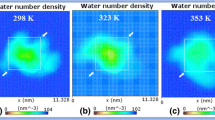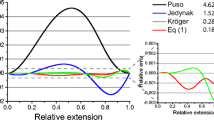Abstract
A statistical mechanical model of protein conformation with medium-range interactions between theith and (i+k)th residues (k<-4) is presented. Two two-state models, an α-helix-coil and an extended-structure-coil model, are formulated using the same form of the partition function, but the two models are applied independently to predict the locations of α-helical, extended, and coil segments; in the relatively few cases (<2%) where the predictions from the two models are in conflict, the prediction is scored as an incorrect one. Two independent sets of statistical weights (one set for each model) are derived to describe the interactions between the 20 amino acid residues for each range of interactionk; they are evaluated by minimizing an objective function so that the probability profiles for the α-helix or extended structure, respectively, in proteins computed from these statistical weights correlate optimally with the experimentally observed native conformations of these proteins. Examination of the resulting statistical weights shows that those for the interactions between hydrophobic residues and between a hydrophobic and a hydrophilic residue have reasonable magnitudes compared to what would be expected from the spatial arrangements of the side chains in the α-helix and the extended structure, and that those for the α-helix-coil model correlate well with experimentally determined values of the Zimm-Bragg parameterss and σ of the helix-coil transition theory. From the point of view of a method to predict the conformational states (i.e., α-helix, extended structure, and coil) of each residue, the statistical weights (as inall empirical prediction schemes) depend very much on the proteins used for the data base, since the presently available set of proteins of known structure is still too small for very high predictability; as a result, the correctness of the prediction is not very good for proteins not included in the data base. However, the correctness of the prediction, at least for the 37 proteins utilized as the data base in this study, is 91% and 87% for the α-helix-coil and the extended-structure-coil models, respectively; further, 79% of all the residues are predicted correctly when both the α-helix-coil and extended-structure-coil models are applied independently.
Similar content being viewed by others
References
Abe, H., and Gō, N. (1981).Biopolymers 20, 1013–1031.
Alter, J. E., Taylor, G. T., and Scheraga, H. A. (1972).Macromolecules 5, 739–746.
Alter, J. E., Andreatta, R. H., Taylor, G. T., and Scheraga, H. A. (1973).Macromolecules 6, 564–570.
Ananthanarayanan, V. S., Andreatta, R. H., Poland, D., and Scheraga, H. A. (1971).Macromolecules 4, 417–424.
Bremermann, H. (1970).Math. Biosci. 9, 1–15.
Chang, M. C., Fredrickson, R. A., Powers, S. P., and Scheraga, H. A. (1981).Macromolecules 14, 633–634.
Denton, J. B., Powers, S. P., Zweifel, B. O., and Scheraga, H. A. (1982).Biopolymers 21, 51–77.
Dunfield, L. G., and Scheraga, H. A. (1980).Macromolecules 13, 1415–1428.
Dygert, M. K., Taylor, G. T., Cardinaux, F., and Scheraga, H. A. (1976).Macromolecules 9, 794–801.
Frederickson, R. A., Chang, M. C., Powers, S. P., and Scheraga, H. A. (1981).Macromolecules 14, 625–632.
Gō, N., and Abe, H. (1981).Biopolymers 20, 991–1011.
Hecht, M. H., Zweifel, B. O., and Scheraga, H. A. (1978).Macromolecules 11, 545–551.
Hill, D. J. T., Cardinaux, F., and Scheraga, H. A. (1977).Biopolymers 16, 2447–2467.
Hughes, L. J., Andreatta, R. H., and Scheraga, H. A. (1972).Macromolecules 5, 187–197.
Isogai, Y., Némethy, G., Rackovsky, S., Leach, S. J., and Scheraga, H. A. (1980).Biopolymers 19, 1183–1210.
Kobayashi, Y., Cardinaux, F., Zweifel, B. O., and Scheraga, H. A. (1977).Macromolecules 10, 1271–1283.
Konishi, Y., Van Nispen, J. W., Davenport, G., and Scheraga, H. A. (1977).Macromolecules 10, 1264–1271.
Lewis, P. N., and Scheraga, H. A. (1971a).Arch. Biochem. Biophys. 144, 576–583.
Lewis, P. N., and Scheraga, H. A. (1971b).Arch. Biochem. Biophys. 144, 584–588.
Lewis, P. N., Gō, N., Gō, M., Kotelchuck, D., and Scheraga, H. A. (1970).Proc. Natl. Acad. Sci. USA 65, 810–815.
Matheson, Jr., R. R., and Scheraga, H. A. (1983).Macromolecules, in press.
Matheson, Jr., R. R., Nemenoff, R. A., Cardinaux, F., and Scheraga, H. A. (1977).Biopolymers 16, 1567–1585.
Maxfield, F. R., and Scheraga, H. A. (1976).Biochemistry 15, 5138–5153.
Maxfield, F. R., and Scheraga, H. A. (1979).Biochemistry 18, 697–704.
Maxfield, F. R., Alter, J. E., Taylor, G. T., and Scheraga, H. A. (1975).Macromolecules 8, 479–491.
Meirovitch, H., and Scheraga, H. A. (1981a).Macromolecules 14, 1250–1259.
Meirovitch, H., and Scheraga, H. A. (198b).Proc. Natl. Acad. Sci. USA 78, 6584–6587.
Meirovitch, H., Rackovsky, S., and Scheraga, H. A. (1980).Macromolecules 13, 1398–1405.
Nagano, K. (1973).J. Mol. Biol. 75, 401–420.
Nagy, J. A., Powers, S. P., Zweifel, B. O., and Scheraga, H. A. (1980).Macromolecules 13, 1428–1440.
Platzer, K. E. B., Ananthanarayanan, V. S., Andreatta, R. H., and Scheraga, H. A. (1972).Macromolecules 5, 177–187.
Poland, D., and Scheraga, H. A. (1969).Physiol. Chem. Phys. 1, 389–446.
Poland, D., and Scheraga, H. A. (1970).Theory of Helix-Coil Transitions in Biopolymers, Academic, New York, Chapter 9.
Ponnuswamy, P. K., Warme, P. K., and Scheraga, H. A. (1973).Proc. Natl. Acad. Sci. USA 70, 830–833.
Robson, B., and Suzuki, E. (1976).J. Mol. Biol. 107, 327–356.
Scheraga, H. A. (1973).Pure Appl. Chem. 36, 1–8.
Scheraga, H. A. (1983).Biopolymers 22, 1–14.
Scheule, R. K., Cardinaux, F., Taylor, G. T., and Scheraga, H. A. (1976).Macromolecules 9, 23–33.
Schiffer, M., and Edmundson, A. B. (1967).Biophys. J. 7, 121–135.
Schulz, G. E., and Schirmer, R. H. (1979).Principles of Protein Structure, Springer-Verlag, New York, Chapter 6.
Tanaka, S., and Scheraga, H. A. (1976a).Macromolecules 9, 142–159.
Tanaka, S., and Scheraga, H. A. (1976b).Macromolecules 9, 159–167.
Tanaka, S., and Scheraga, H. A. (1976c).Macromolecules 9, 168–182.
Tanaka, S., and Scheraga, H. A. (1976d).Macromolecules 9, 812–833.
Tanaka, S., and Scheraga, H. A. (1977).Macromolecules 10, 9–20.
Tanaka, S., and Scheraga, H. A. (1977b).Macromolecules 10, 305–316.
Van Nispen, J. W., Hill, D. J., and Scheraga, H. A. (1977).Biopolymers 16, 1587–1592.
Van Wart, H. E., Taylor, G. T., and Scheraga, H. A. (1973).Macromolecules 6, 266–273.
Von Dreele, P. H., Poland, D., and Scheraga, H. A. (1971a).Macromolecules 4, 396–407.
Von Dreele, P. H., Lotan, N., Ananthanarayanan, V. S., Andreatta, R. H., Poland, D., and Scheraga, H. A. (1971b).Macromolecules 4, 408–417.
Wako, H., and Saitô, N. (1978a).J. Phys. Soc. Jpn. 44, 1931–1938.
Wako, H., and Saitô, N. (1978b).J. Phys. Soc. Jpn. 44, 1939–1945.
Wako, H., and Scheraga, H. A. (1982a).Biopolymers 21, 611–632.
Wako, H., and Scheraga, H. A. (1982b).J. Protein Chem. 1, 5–45.
Wako, H., and Scheraga, H. A. (1982c).J. Protein Chem. 1, 85–117.
Wertz, D. H., and Scheraga, H. A. (1978).Macromolecules 11, 9–15.
Zimm, B. H., and Bragg, J. K. (1959).J. Chem. Phys. 31, 526–535.
Author information
Authors and Affiliations
Rights and permissions
About this article
Cite this article
Wako, H., Saitô, N. & Scheraga, H.A. Statistical mechanical treatment of α-helices and extended structures in proteins with inclusion of short- and medium-range interactions. J Protein Chem 2, 221–249 (1983). https://doi.org/10.1007/BF01025356
Received:
Published:
Issue Date:
DOI: https://doi.org/10.1007/BF01025356




